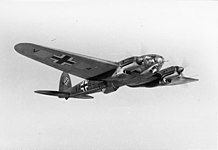Blaich special command
The Sonderkommando Blaich was a German special unit that had a Heinkel He 111 and an Italian Savoia SM.81 . With these two aircraft, the command carried out long-range attacks on targets in French Equatorial Africa in January 1942 .
The first attack against a target 2010 km from the German-Italian bases in North Africa was a success, but on the return flight the German aircraft ran out of fuel and had to make an emergency landing. The crew and aircraft were recovered a week later.
background
The Chad with its capital Fort Lamy were since 1940 under the control of the Free French Forces and an important base for operations against the Kufra as well as a supply point for the RAF and the SAS on the route from Takoradi in Ghana to Egypt .
Captain Theo Blaich - a German adventurer and plantation owner who signed up for service in the Wehrmacht in 1939 and arrived in his own Messerschmitt Bf 108 Taifun - recognized the importance of Fort Lamy as a waypoint on the land transport and communication route from the west coast of Africa to the Nile , as well as a rallying point for Allied operations. Blaich proposed the capture of Fort Lamy to protect the southern border of Libya. When his suggestions were not taken seriously in Berlin , he suggested that at least one bomb attack be carried out.
Blaich found a more interested supporter in Erwin Rommel , who agreed to the idea and passed it on to Fliegerführer Afrika. The date for the operation was set for January 21, 1942 in support of Rommel's offensive against the British defense at El Agheila.
Blaich's command left the Hun oasis on January 20 and consisted of German and Italian soldiers and three aircraft, an He 111, a Savoia and Blaich's Typhoon. The following six members of the group were to carry out an air strike while the Italian crew was left without their pilot:
- Captain Theo Blaich, Typhoon pilot
- Lieutenant Franz Bohnsack, pilot of the He 111
- Oberstabsfeldwebel Heinrich Geissler, engineer
- Sergeant Wolfgang Wichmann, radio operator
- Lieutenant Fritz Dettmann, war correspondent
- Major Roberto Graf Vimercati-San Severino, desert expert in the Italian army and pilot of the Savoia
The small group flew to the remote natural airfield Campo Uno in southern Libya, which had been discovered by Count Roberto Vimercati-San Severino in 1935 when he landed there on a safari . He measured and later marked the area, but there was a lack of technical facilities. For the purpose of supply, the small group used the Savoia for supply.
commitment
The command's Heinkel He 111 took off from Campo Uno on January 21 at 8:00 a.m., but experienced bad weather, contrary to the weather forecast. The aircraft had been loaded with 1000 gallons of fuel and the supply had been carefully calculated due to the inclement weather and the aircraft using more fuel than expected.
The plane reached Lake Chad around noon , after which navigation became easier despite the worsening storm. At 2:30 p.m. the plane reached Fort Lamy. There was no air defense at Fort Lamy and they were able to drop their 16 bombs, 800 kg of explosives, unhindered. The French forces were too surprised to organize an air defense and 80,000 gallons of fuel and oil were destroyed, and possibly up to ten planes.
The plane returned north undamaged, but the crew found it difficult to navigate. By the time darkness fell, the plane was almost without fuel and the crew knew they would not be able to find the way back to Campo Uno. Since the aircraft had a 100 m antenna (towed antenna) that it could extend if necessary, it released the antenna and sent an SOS. However, no reply was received. Finally the plane had to make an emergency landing. Bohnsack was able to land the aircraft without damage and the crew tried unsuccessfully to contact the air force headquarters in Agedabia in Libya at the agreed time . The crew still had supplies for six days.
After two days at their landing site, probably 190 km from Campo Uno, the crew was able to contact the German headquarters.
On January 27, the stranded crew was discovered by an Italian reconnaissance aircraft (Caproni Ca.309 Ghibli), which they again supplied with food and water. The following day a Junkers 52 transport plane brought fuel from Agedabia after embarking on an unauthorized search for Blaich's missing command, and the plane and crew were able to return to Campo Uno.
aftermath
The attack on Fort Lamy caused little damage to facilities and losses, but destroyed vital fuel supplies, although various efforts were made to save them. It halved the supplies available to the French Free Forces and RAF in the region. The raid caused the French General Philippe Leclerc to strengthen the air defense in Fort Lamy and to take action against the Italian armed forces in the Fezzan region .
Blaich and his Sonderkommando continued their operations against the British Long Range Desert Group in the first half of 1942. In June 1942, the unit's Heinkel bomber crashed near Kufra after an engine failure. The crew was rescued four days later, as a result of which the operations of the Sonderkommando were suspended.
literature
- David Oliver: Airborne Espionage: International Special Duty Operations in the World Wars. United Kingdom: The History Press. 2005. ISBN 978-0-7524-9552-1 .
- William Mortimer Moore: Free France's Lion: The Life of Philippe Leclerc, de Gaulle's Greatest General. United Kingdom: Casemate Publishers. 2011. ISBN 978-1-61200-080-0 .
- Wolfgang Wichmann: Hussar coup against Fort Lamy , Flugzeug Magazin, No 5, October / November 1986
